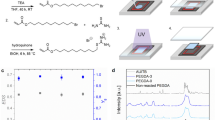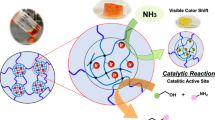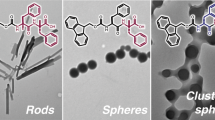Abstract
A series of biobased polyimides bearing a structure derived from a predetermined tetracarboxylic dianhydride was synthesized. By ionizing the COOH group of the side chain with potassium hydroxide, four kinds of polyimides were solubilized in water, and the water-soluble polyimides were cast onto films over an aqueous solution, leading to higher optical transparency than that of non-water-soluble polyimides. 1H nuclear magnetic resonance measurements of the polyimides revealed no residual reactants from the polymerization process or side-chain modification. Partial crosslinking of the water-soluble polyimide chains by condensation of the carboxylate side chain with an amino acid-based diamine such as 4-aminophenylalanine or 4,4′-diamino-α-truxillic acid induced the formation of polyimide hydrogels. The remaining COOK groups of the obtained hydrogel were protonated/deprotonated by changing the pH, accompanied by reversible shrinking and swelling.
This is a preview of subscription content, access via your institution
Access options
Subscribe to this journal
Receive 12 print issues and online access
$259.00 per year
only $21.58 per issue
Buy this article
- Purchase on Springer Link
- Instant access to full article PDF
Prices may be subject to local taxes which are calculated during checkout






Similar content being viewed by others
References
Gong JP. Materials both tough and soft. Science. 2014;344:161–2.
Cui K, Gong JP. Aggregated structures and their functionalities in hydrogels. Aggregate. 2021;2:e33.
Nakajima T. Generalization of the sacrificial bond principle for gel and elastomer toughening. Polym J. 2017;49:477–85.
Qiu Y, Park K. Environment-sensitive hydrogels for drug delivery. Adv Drug Deliv Rev. 2001;53:321–39.
Peppas NA, Hilt JZ, Khademhosseini A, Langer R. Hydrogels in biology and medicine: from molecular principles to bionanotechnology. Adv Mater. 2006;18:1345–60.
Calvert P. Hydrogels for soft machines. Adv Mater. 2009;21:743–56.
Bajpai AK, Shukla SK, Bhanu S, Kankane S. Responsive polymers in controlled drug delivery. Prog Polym Sci. 2008;33:1088–118.
Hirotsu S, Hirokawa Y, Tanaka T. Volume‐phase transitions of ionized N‐isopropylacrylamide gels. J Chem Phys. 1987;87:1392–5.
Yu H, Grainger DW. Thermo-sensitive swelling behavior in crosslinked N-isopropylacrylamide networks: cationic, anionic, and ampholytic hydrogels. J Appl Polym Sci. 1993;49:1553–63.
Schild HG. Poly(N-isopropylacrylamide): experiment, theory and application. Prog Polym Sci. 1992;17:163–249.
Halperin A, Kröger M, Winnik FM. Poly(N-isopropylacrylamide) phase diagrams: fifty years of research. Angew Chem Int Ed. 2015;54:15342–67.
Xue N, Qiu X-P, Chen Y, Satoh T, Kakuchi T, Winnik FM. Effect of chain architecture on the phase transition of star and cyclic poly(N-isopropylacrylamide) in water. J Polym Sci Part B: Polym Phys. 2016;54:2059–68.
Li J, Kikuchi S, Sato S, Chen Y, Xu L, Song B, et al. Core-first synthesis and thermoresponsive property of three-, four-, and six-arm star-shaped poly(N,N-diethylacrylamide)s and their block copolymers with poly(N,N-dimethylacrylamide). Macromolecules. 2019;52:7207–17.
Kikuchi S, Chen Y, Ichinohe E, Kitano K, Sato S, Duan Q, et al. Synthesis and thermoresponsive property of linear, cyclic, and star-shaped poly(N,N-diethylacrylamide)s using B(C6F5)3-catalyzed group transfer polymerization as facile end-functionalization method. Macromolecules. 2016;49:4828–38.
Firestone BA, Siegel RA. Kinetics and mechanisms of water sorption in hydrophobic, ionizable copolymer gels. J Appl Polym Sci. 1991;43:901–14.
Rasal RM, Janorkar AV, Hirt DE. Poly(lactic acid) modifications. Prog Polym Sci. 2010;35:338–56.
Auras R, Harte B, Selke S. An overview of polylactides as packaging materials. Macromol Biosci. 2004;4:835–64.
Middleton JC, Tipton AJ. Synthetic biodegradable polymers as orthopedic devices. Biomaterials. 2000;21:2335–46.
Banerjee R, Ray SS. An overview of the recent advances in polylactide-based sustainable nanocomposites. Polym Eng Sci. 2021;61:617–49.
Yum S, Kim H, Seo Y. Synthesis and characterization of isosorbide based polycarbonates. Polymer. 2019;179:121685.
Zhang Z, Xu F, He H, Ding W, Fang W, Sun W, et al. Synthesis of high-molecular weight isosorbide-based polycarbonates through efficient activation of endo-hydroxyl groups by an ionic liquid. Green Chem. 2019;21:3891–901.
Rose M, Palkovits R. Isosorbide as a renewable platform chemical for versatile applications—quo vadis? ChemSusChem. 2012;5:167–76.
Froidevaux V, Negrell C, Caillol S, Pascault JP, Boutevin B. Biobased amines: from synthesis to polymers; present and future. Chem Rev. 2016;116:14181–224.
Wilbon PA, Chu F, Tang C. Progress in renewable polymers from natural terpenes, terpenoids, and rosin. Macromol Rapid Commun. 2013;34:8–37.
Hadjichristidis N, Iatrou H, Pitsikalis M, Sakellariou G. Synthesis of well-defined polypeptide-based materials via the ring-opening polymerization of α-amino acid N-carboxyanhydrides. Chem Rev. 2009;109:5528–78.
Khadka DB, Cross MC, Haynie DT. A synthetic polypeptide electrospun biomaterial. ACS Appl Mater Interfaces. 2011;3:2994–3001.
Kaneko T, Ali MA, Captain I, Perlin P, Deming TJ. Polypeptide gels incorporating the exotic functional aromatic amino acid 4-amino-l-phenylalanine. Polym Chem. 2018;9:3466–72.
Bellomo EG, Wyrsta MD, Pakstis L, Pochan DJ, Deming TJ. Stimuli-responsive polypeptide vesicles by conformation-specific assembly. Nat Mater. 2004;3:244–8.
Okajima MK, Bamba T, Kaneso Y, Hirata K, Fukusaki E, Kajiyama SI, et al. Supergiant ampholytic sugar chains with imbalanced charge ratio form saline ultra-absorbent hydrogels. Macromolecules. 2008;41:4061–4.
Duan H, Shao Z, Zhao M, Zhou Z. Preparation and properties of environmental-friendly coatings based on carboxymethyl cellulose nitrate ester & modified alkyd. Carbohydr Polym. 2016;137:92–9.
Williams DBG, Mason JM, Tristram CJ, Hinkley SFR. Cellulose as a source of water dispersible renewable film-forming materials. Macromolecules. 2015;48:8497–508.
Okeyoshi K, Okajima MK, Kaneko T. The cyanobacterial polysaccharide sacran: characteristics, structures, and preparation of LC gels. Polym J. 2021;53:81–91.
Okeyoshi K, Okajima MK, Kaneko T. Milliscale self-integration of megamolecule biopolymers on a drying gas–aqueous liquid crystalline interface. Biomacromolecules. 2016;17:2096–103.
Funaki T, Kaneko T, Yamaoka K, Ohsedo Y, Gong JP, Osada Y, et al. Shear-induced mesophase organization of polyanionic rigid rods in aqueous solution. Langmuir. 2004;20:6518–20.
Ono Y, Goto R, Hara M, Nagano S, Abe T, Nagao Y. High proton conduction of organized sulfonated polyimide thin films with planar and bent backbones. Macromolecules. 2018;51:3351–9.
Nagao Y, Ohno K, Tsuyuki S, Suetsugu K, Hara M, Nagano S. Effect of molecular orientation to proton conductivity in sulfonated polyimides with bent backbones. Mol Cryst Liq Cryst. 2019;686:84–91.
Takakura K, Ono Y, Suetsugu K, Hara M, Nagano S, Abe T, et al. Lyotropic ordering for high proton conductivity in sulfonated semialiphatic polyimide thin films. Polym J. 2019;51:31–9.
Shigekura Y, Chen YM, Furukawa H, Kaneko T, Kaneko D, Osada Y, et al. Anisotropic polyion-complex gels from template polymerization. Adv Mater. 2005;17:2695–9.
Dwivedi S, Nag A, Sakamoto S, Funahashi Y, Harimoto T, Takada K, et al. High-temperature resistant water-soluble polymers derived from exotic amino acids. RSC Adv. 2020;10:38069–74.
Falamarzian M, Varshosaz J. The effect of structural changes on swelling kinetics of polybasic/hydrophobic pH-sensitive hydrogels. Drug Dev Ind Pharm. 1998;24:667–9.
Kou JH, Amidon GL, Lee PI. pH-dependent swelling and solute diffusion characteristics of poly(hydroxyethyl methacrylate–CO–methacrylie acid) hydrogels. Pharm Res. 1988;5:592–7.
Brannon-Peppas L, Peppas NA. Dynamic and equilibrium swelling behaviour of pH-sensitive hydrogels containing 2-hydroxyethyl methacrylate. Biomaterials. 1990;11:635–44.
Suvannasara P, Tateyama S, Miyasato A, Matsumura K, Shimoda T, Ito T, et al. Biobased polyimides from 4-aminocinnamic acid photodimer. Macromolecules. 2014;47:1586–93.
Dwivedi S, Kaneko T. Molecular design of soluble biopolyimide with high rigidity. Polymers. 2018;10:4.
Shin H, Wang S, Tateyama S, Kaneko D, Kaneko T. Preparation of a ductile biopolyimide film by copolymerization. Ind Eng Chem Res. 2016;55:8761–6.
Takada K, Shinagawa H, Morita Y, Grewal MS, Taya K, Kumar A, et al. Syntheses of soluble biopolyimides using 4-aminophenylalanine. Chin J Polym Sci. 2020;38:1117–23.
Amornwachirabodee K, Okajima MK, Kaneko T. Uniaxial swelling in LC hydrogels formed by two-step cross-linking. Macromolecules. 2015;48:8615–21.
Acknowledgements
This work was financially supported by the Shibuya Science and Sports Culture Foundation and partially supported by the Japan Society for the Promotion of Science of Grant-in-Aid for Early-Career Scientists (21K14681) and Super Highways (Japan Science and Technology Agency), Japan.
Author information
Authors and Affiliations
Corresponding authors
Ethics declarations
Conflict of interest
The authors declare no competing financial interests.
Additional information
Publisher’s note Springer Nature remains neutral with regard to jurisdictional claims in published maps and institutional affiliations.
Supplementary information
Rights and permissions
About this article
Cite this article
Takada, K., Noda, T., Kobayashi, T. et al. Synthesis of pH-responsive polyimide hydrogel from bioderived amino acid. Polym J 53, 1223–1230 (2021). https://doi.org/10.1038/s41428-021-00509-8
Received:
Revised:
Accepted:
Published:
Issue Date:
DOI: https://doi.org/10.1038/s41428-021-00509-8
This article is cited by
-
Synthesis of biobased functional materials using photoactive cinnamate derivatives
Polymer Journal (2023)



